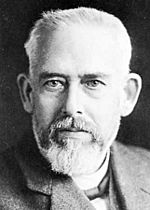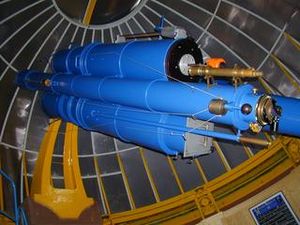Max Wolf facts for kids
Quick facts for kids
Max Wolf
|
|
|---|---|

Max Wolf
|
|
| Born |
Maximilian Franz Joseph Cornelius Wolf
21 June 1863 |
| Died | 3 October 1932 (aged 69) Heidelberg, Germany
|
| Nationality | German |
| Alma mater | University of Heidelberg |
| Known for | Astrophotography |
| Awards | Bruce Medal (1930) |
| Scientific career | |
| Fields | Astronomy |
| Institutions | University of Heidelberg |
| Doctoral advisor | Leo Königsberger |
| Doctoral students | August Kopff Heinrich Vogt |
| see § List of discovered minor planets |
Max Wolf (born June 21, 1863 – died October 3, 1932) was a famous German astronomer. He was one of the first to use astrophotography (taking pictures of space) to discover new things in the sky. Max Wolf led the astronomy department at the University of Heidelberg and was the director of the Heidelberg-Königstuhl State Observatory from 1902 until he passed away.
Contents
Early Life of Max Wolf
Max Wolf was born in Heidelberg, Germany, on June 21, 1863. His father, Franz Wolf, was a doctor who loved science. He even built an observatory in their garden for young Max! From this backyard observatory, Max made his first big discovery in 1884: a comet named 14P/Wolf.
Max Wolf's University Years
Max Wolf went to the local University of Heidelberg. In 1888, when he was 25, he earned his Ph.D. (a very high university degree). He spent only one year studying outside Heidelberg, in Stockholm. Most of his life was spent in his hometown.
In 1890, he returned to the University of Heidelberg as a privat-docent. This was a special teaching position. He was a very popular astronomy teacher. Many other universities wanted him, but he chose to stay in Heidelberg. In 1902, he became the head of astronomy and the director of the new Landessternwarte Heidelberg-Königstuhl observatory. He held these important jobs until he died in 1932.
Building the Observatory
While the new observatory was being built, Max Wolf was in charge of setting up its astrophysics section. He was great at supervising and also at raising money! He traveled to America to learn about building large telescopes. He came back with plans and a $10,000 gift from an American helper named Catherine Wolfe Bruce.
Wolf quickly designed a special telescope called the Bruce double-astrograph. It had two parallel lenses, each 16 inches (41 cm) wide. This telescope became the main tool for research at the observatory. He also raised money for a 28-inch (71 cm) reflector telescope, which was used to study light from space.
In 1910, Wolf suggested a new invention to the Carl Zeiss company: the planetarium. This amazing machine projects images of stars and planets onto a dome. World War I delayed the project, but it was finished later. The first public planetarium show was in Munich, Germany, on October 21, 1923.
Working with E.E. Barnard
During his trip to America, Max Wolf learned a lot about astrophotography. He met an American astronomer named E.E. Barnard. They became lifelong friends, rivals, and partners in discovery. Wolf even wrote a long tribute when Barnard passed away in 1923.
Max Wolf's Later Life and Discoveries
Under Max Wolf's leadership, Heidelberg University became very famous for astronomy. Wolf himself was always busy researching. He wrote many important papers about space until the end of his life. He died in Heidelberg on October 3, 1932, at 69 years old.
Comets and Novae
Max Wolf began his career by searching for comets. He found several throughout his life, including 14P/Wolf and 43P/Wolf-Harrington. He even won a friendly contest with E. E. Barnard to be the first to see Halley's Comet return in April 1910.
He also discovered Nova Aquilae 1927, which is a type of star that suddenly becomes very bright. He found or helped find four supernovae (huge star explosions).
Dark Nebulae
One of Max Wolf's most important discoveries was understanding dark nebulae. For a long time, astronomers like William Herschel thought these dark areas in the sky were "holes." But Wolf, working with E. E. Barnard, used careful photography to prove that dark nebulae are actually giant clouds of fine, dark dust that block starlight.
Star Catalog
Max Wolf and E. E. Barnard used astrophotography to study stars. The Bruce double-astrograph telescope was first made to find faint asteroids. But it was also perfect for studying how dim stars move across the sky, called their proper motion.
In 1919, Wolf published a catalog with the locations and movements of over a thousand stars. These stars are still known by his name and catalog number. One famous star he found is Wolf 359, a dim red dwarf star. It was later found to be one of the closest stars to our Solar System. Wolf kept adding to his catalog, finding over 1500 stars. Stars with low brightness and high proper motion are usually close to Earth. This makes the stars in Wolf's catalog very important for astronomers today.
Max Wolf's Asteroid Discoveries
In 1891, Wolf discovered his first asteroid, 323 Brucia. He named it after Catherine Wolfe Bruce, who had helped fund his work. He was a pioneer in using astrophotography to find asteroids. Before him, astronomers had to look through telescopes to find them. With photography, asteroids appeared as short streaks on long-exposure pictures, making them much easier to spot. This new method greatly increased how many asteroids were discovered. Wolf found 248 asteroids in his lifetime!
Among his many discoveries, he found 588 Achilles in 1906. This was the first Trojan asteroid, a special type of asteroid that shares an orbit with a planet. He also found two other Trojans: 659 Nestor and 884 Priamus. In 1918, he discovered 887 Alinda, which is an Amor asteroid that crosses Earth's orbit. His student, Karl Wilhelm Reinmuth, later broke Wolf's record for asteroid discoveries in 1933.
Awards and Honors for Max Wolf
Max Wolf received many important awards for his work:
- The Prix Jules Janssen in 1912, which is the top award from the French astronomical society.
- The Gold Medal of the Royal Astronomical Society in 1914.
- The Bruce Medal in 1930.
A crater on the Moon called Wolf was named after him. Also, two asteroids, 827 Wolfiana and 1217 Maximiliana, were named in his honor.
Another asteroid, 1152 Pawona, is named after both Max Wolf and another astronomer, Johann Palisa. The name "Pawona" combines parts of their last names.
Other Astronomers Named Wolf
It can be a bit confusing, but there are other astronomers with the last name "Wolf"!
- Marek Wolf is a Czech astronomer who also discovers minor planets. His discoveries are listed as "M. Wolf."
- Charles Wolf was a French astronomer who helped discover special stars called Wolf-Rayet stars.
- Other astronomers like Christian Wolf and Ulrich Wolff have also found minor planets.
See also
 In Spanish: Max Wolf para niños
In Spanish: Max Wolf para niños


